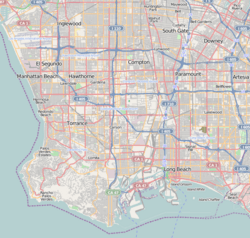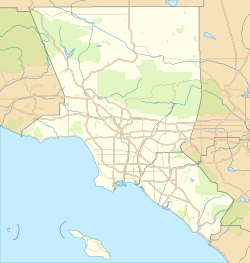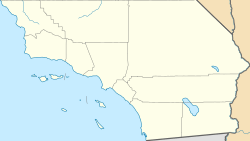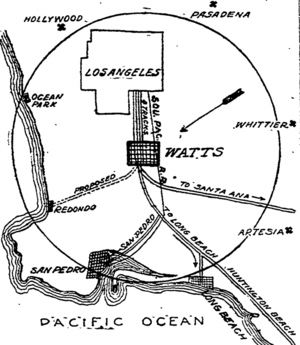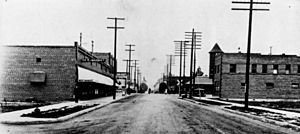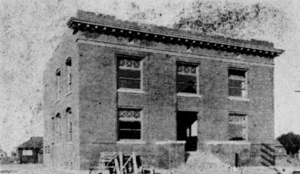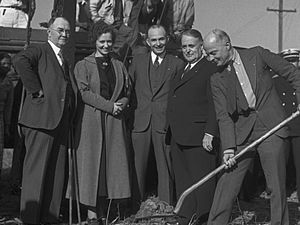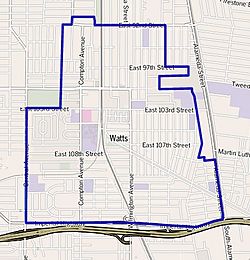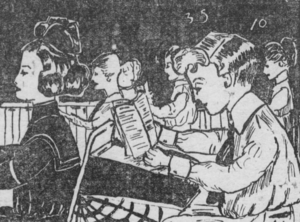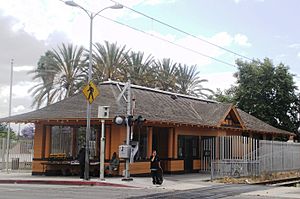Watts, Los Angeles facts for kids
Quick facts for kids
Watts
|
|
|---|---|
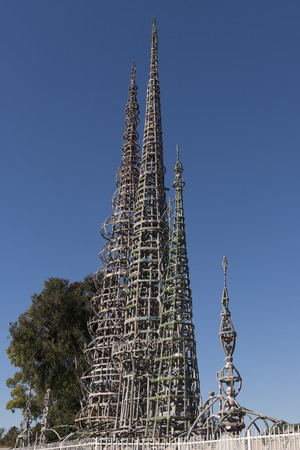
The Watts Towers, created by Simon Rodia
|
|
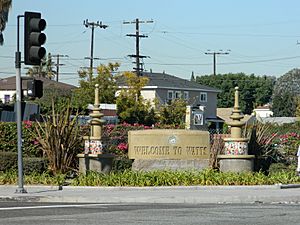
"Welcome to Watts" sign on Central Avenue
|
|
| Country | United States |
| State | California |
| County | Los Angeles |
| City | Los Angeles |
| Area | |
| • Total | 2.0 sq mi (5 km2) |
| Population
(2000)
|
|
| • Total | 34,830 |
| • Density | 17,350/sq mi (6,700/km2) |
| ZIP Code |
90002, 90059
|
| Area code(s) | 323 |
| Website | Watts Neighborhood Council |
Watts is a neighborhood in southern Los Angeles, California. It is part of the South Los Angeles area. Watts borders cities like Lynwood and South Gate. It also borders the community of Willowbrook to the south.
Watts started as a ranching community in the late 1800s. The arrival of railroads helped it grow quickly. It became an independent city, but in 1926, it joined Los Angeles. By the 1940s, many African-American families lived there. Over time, Watts faced economic challenges.
Today, Watts is mostly Hispanic, with a large African-American population. Even with challenges, the community is active. Residents organize events like "Toys for Watts" and the Watts Christmas parade. They also hold the "Watts Summer Games" athletic tournament. There is a local theatre and a dance company, all working to improve the neighborhood.
Watts is famous worldwide for the Watts Towers. These amazing structures were built by Simon Rodia. They are a special landmark in Los Angeles and are listed on the National Register of Historic Places. Watts has also appeared in many movies and TV shows. It is often mentioned in West Coast hip-hop music.
Contents
History of Watts
How Watts Began
The land where Watts is located was once part of a Mexican land grant from 1843. Back then, the main activity was raising cattle. People started settling in the area around 1882. By 1904, about 65 people lived there. Just one year later, the population grew to 1,651. C.V. Bartow, from Long Beach, is known as one of the founders of Watts.
How Watts Got Its Name
In 1904, people said Watts was named after Charles H. Watts. He was a businessman from Pasadena. He owned a ranch where the Salt Lake railroad passed through. The station was named after him.
However, in 1919, Watts Mayor Z. A. Towne offered a different story. He said the settlement was named after a widow. She owned ten acres of land where a Pacific Electric power station later stood.
Around 1912 and 1913, there was a push to change the name of Watts. Residents were tired of jokes about the town. One real estate agent said clients would not visit properties once they knew the streetcar went to Watts. The name "South Angeles" was suggested. In 1919, Mayor Towne said Watts had a "bad reputation." He believed a new name could help the community.
Early Growth and Development
A new housing area called Watts was planned between 1903 and 1905. At that time, about 150 people lived there. Lots were sold for $100 to $200. You could pay a dollar down and a dollar a month.
After 1903, Watts saw many new businesses. These included a newspaper, a general store, and a lumber yard. There were also grocery stores, bakeries, and a blacksmith shop. A large laundry company opened in 1907. It promised many jobs and used the electric railway for deliveries.
Becoming a City
Watts officially became a city in May 1907. J. F. Donahue became the first mayor. However, the new city had no money to operate. This was because it became a city too late to collect taxes. Residents then voted to allow saloons (bars) to be taxed. This helped the city raise money.
In 1908, Watts became known nationwide. This was because of a musical comedy called "Lonesome Town." It was set in an imaginary place called Watts, California. The play ran for 88 shows in New York.
To counter the jokes from the play, Watts held a "big advertising excursion" in 1912. Special electric trains took people on a tour. The goal was to show that Watts was "born again." They wanted people to think of it as "Lucky Watts." This event was repeated in 1913.
By 1910, Watts had about 2,500 people. It had paved streets, a fire department, and a newspaper. A new city hall was being built. Watts also had good schools and churches. Businesses included a company that made mining machines. By 1925, Watts had many factories. These included a pump plant, a machine shop, and a steel plant.
Joining Los Angeles City
On April 2, 1926, Watts residents voted to join Los Angeles. The vote was 1,338 to 535. This decision added 23,000 people to Los Angeles. The change took effect on June 1, 1926. Watts Mayor L.A. Edwards supported joining Los Angeles.
Watts did not have a large black population until the 1940s. Before then, some African Americans lived there. Many worked as train porters or cooks. Photos from 1909 and 1911 show only a few black children in classrooms. Rules at the time limited where black families could live.
During World War II, many African Americans moved to California. They came from Southern states looking for better jobs. The city built large housing projects for these new workers. By the early 1960s, these projects were almost entirely black. Many white families had moved to new suburbs. As factory jobs left the area, more poor families lived in the projects. Train service was also stopped in 1961. This made it harder for people to get to jobs.
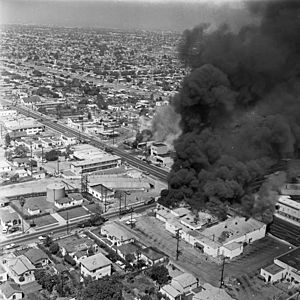
On August 11, 1965, a major event known as the Watts riots occurred. This was due to long-standing anger over how police treated the black community. There was also frustration about poor public services. The riots caused severe damage, especially along 103rd Street. This street was the main shopping area. After the fires, it was called "Charcoal Alley."
A plan was made in 1966 to rebuild the area. The goal was to create a modern shopping district. By 1972, many buildings were torn down. Streets were made wider. New, less dense housing was built. The shopping center was not finished until the early 1980s. These changes made Watts less walkable. It also created more traffic. Later, a "green streets" project started in 2016. This project aims to make the area safer for pedestrians.
Watts faced more challenges in the 1970s. However, community leaders are working to improve Watts's image. They promote local museums and art galleries. The Watts Towers attract many artists. A film called I Build the Tower tells the history of Watts. It also shows the activities at the Watts Towers Arts Center. In 2000, singer Tyrese Gibson started a foundation. It aims to build a community center in Watts.
In 2019, the Watts Towers were a gathering spot. This was during the funeral procession for rapper Nipsey Hussle. Crowds filled the streets to honor him.
Geography of Watts
Watts is a neighborhood in Los Angeles. Its borders are a bit uneven. The northern and eastern edges follow the Los Angeles city limits. However, a small part of Los Angeles County is included. This area is around Ritter Elementary School.
The southern border is Imperial Highway. The eastern border is Alameda Street. The western border is Central Avenue up to 103rd Street. Some county areas, like Ted Watkins Park, are not part of Watts. Then, the border follows Success Avenue between Century Boulevard and 92nd Street.
Watts is next to Florence-Firestone to the north. To the east is South Gate. Lynwood is to the southeast. Willowbrook is to the south. Green Meadows is to the north and west.
Climate in Watts
| Climate data for Watts, Los Angeles | |||||||||||||
|---|---|---|---|---|---|---|---|---|---|---|---|---|---|
| Month | Jan | Feb | Mar | Apr | May | Jun | Jul | Aug | Sep | Oct | Nov | Dec | Year |
| Record high °F (°C) | 91 (33) |
92 (33) |
93 (34) |
105 (41) |
102 (39) |
110 (43) |
107 (42) |
104 (40) |
111 (44) |
106 (41) |
100 (38) |
91 (33) |
111 (44) |
| Mean daily maximum °F (°C) | 68 (20) |
69 (21) |
69 (21) |
72 (22) |
74 (23) |
78 (26) |
82 (28) |
83 (28) |
82 (28) |
78 (26) |
73 (23) |
68 (20) |
75 (24) |
| Mean daily minimum °F (°C) | 47 (8) |
50 (10) |
51 (11) |
53 (12) |
57 (14) |
61 (16) |
64 (18) |
65 (18) |
64 (18) |
59 (15) |
52 (11) |
47 (8) |
56 (13) |
| Record low °F (°C) | 24 (−4) |
31 (−1) |
32 (0) |
37 (3) |
40 (4) |
43 (6) |
47 (8) |
46 (8) |
45 (7) |
40 (4) |
33 (1) |
30 (−1) |
24 (−4) |
| Average precipitation inches (mm) | 3.23 (82) |
3.56 (90) |
2.86 (73) |
0.71 (18) |
0.25 (6.4) |
0.08 (2.0) |
0.02 (0.51) |
0.14 (3.6) |
0.29 (7.4) |
0.40 (10) |
1.14 (29) |
1.86 (47) |
14.53 (369) |
People of Watts
In 2000, about 36,815 people lived in Watts. This means there were about 17,346 people per square mile. This is one of the highest population densities in Los Angeles. By 2008, the population was estimated at 41,028. Watts has a very young population. The average age was 21, and many residents were under 18.
Most people in Watts are Hispanic (61.6%). Black residents make up 37.1% of the population. A small number are non-Hispanic whites (0.5%) or Asian (0.2%). About 34% of residents were born outside the U.S. Most came from Mexico and El Salvador.
The average household income in 2008 was $25,161. This is considered low for the city and county. Many households earned $20,000 or less. The average household size was 4 people, which is high for the city. Most homes (67%) were rented.
In 2000, 38.9% of families were headed by single parents. This was the highest rate in the city. Also, many adults had never been married. Only 2.9% of Watts residents aged 25 and older had a four-year college degree. This is a low number compared to the rest of the city. Many residents also had less than a high school diploma.
Education in Watts
Watts had a school very early on. In 1905, plans were made to expand the school building. A new building was built in 1911 for $30,000. By 1914, this school was too crowded. Desks were placed in hallways and the auditorium. There were 630 students and 18 teachers.
Older students used to go to Redondo Union High School. Later, Watts was part of the Compton School District. In 1914, Watts residents wanted their own high school. They planned to build one for about $100,000. By 1925, Watts voters approved $170,000 for a new high school. The town had four public elementary schools and one Catholic school.
Schools in Watts Today
Here are some of the schools located in Watts:
- Jordan Senior High School, LAUSD, 2265 East 103rd Street
- Animo College Prep Academy, Green Dot Public Schools, 2265 East 103rd Street [1]
- Thomas Riley High School, LAUSD alternative, 1524 East 103rd Street
- Alliance Cindy & Bill Simon Technology High School, charter school, 10720 South Wilmington Avenue
- Verbum Dei High School, private, 11100 South Central Avenue
- Simon Rodia Continuation School, LAUSD, 2315 East 103rd Street
- Edwin Markham Middle School, LAUSD, 1650 East 104th Street
- Ninety-Sixth Street Elementary School, LAUSD, 1471 East 96th Street
- St. Lawrence of Brindisi Elementary School, 10044 Compton Avenue
- Weigand Avenue Elementary School, LAUSD, 10401 Weigand Avenue
- Dorothy V. Johnson Community Day School, LAUSD, 10601 South Grandee Avenue
- San Miguel Catholic School, private elementary, 2270 East 108th Street
- Lovelia P. Flournoy Elementary School, LAUSD, 1630 East 111th Street
- Grape Street Elementary School, LAUSD, 1940 East 111th Street
- Ritter Elementary School, LAUSD, 11108 Watts Avenue
- Ninety-Second Street Elementary School, LAUSD, 9211 Grape Street
- Alain Leroy Locke College Preparatory Academy, Green Dot Public Schools grades 9–12, 325 East 111th Street
- Compton Avenue Elementary School, 1515 East 104th Street
- 112th Street Elementary School, E 112th St, Los Angeles, CA 90059
King Drew Magnet High School of Medicine and Science opened in 1982. It moved to its own campus in Willowbrook in 1999.
In 2013, the principal of Wiegand Avenue Elementary School was removed. This happened because of a state law. Many teachers then asked to transfer to other schools.
Public Libraries in Watts
A public library was started in Watts in 1913. In the same year, Watts got approval to build a new Carnegie Library. The library's foundation was laid in January 1914. When Los Angeles took over Watts in 1926, the library became part of the Los Angeles library system.
A new Watts Branch library opened in 1960. In 1991, the Los Angeles City Council approved building an even newer library. This new library was part of the Watts Civic Center. It opened on June 29, 1996. The city council named it the Alma Reaves Woods–Watts Branch. This was to honor Alma Reaves Woods, who encouraged reading in the community. The Los Angeles Public Library operates this branch.
Community Activities and Services
CicLAvia Tour in Watts
On January 22, 2012, a popular cycling event called CicLAvia came to Watts. Cyclists rode from South L.A.'s Central–Alameda neighborhood to the Watts Towers. Volunteers were excited to host an event in the area. The event aimed to encourage community involvement. Cyclists took photos to create a "crowd-source" map.
Watts Re-Imagined Project
Watts Re:Imagined is a local project focused on urban planning. It is led by Grant Housing Economic Development Corps (Grant EDC). This group works with the Natural Resources Defense Council (NRDC). Their goal is to help Watts reach its full potential. They want to create more economic opportunities. They also aim to improve public health and quality of life. The project works with community leaders to keep Watts's unique identity.
Parks and Recreation in Watts
Watts has several places for recreation:
- Watts Senior Citizen Center, 1657 East Century Boulevard
- 109th Street Recreation Center, 1464 East 109th Street. This center is also a Los Angeles Police Department stop-in point. It has an auditorium and lighted fields for baseball, basketball, football, and soccer. There are also tennis courts. It has indoor and outdoor gyms. There is a children's play area too. The 109th Street Pool is an outdoor pool open in summer.
Attractions in Watts
Watts Towers
The Watts Towers are a group of 17 connected structures. Two of them are over 99 feet (30 m) tall. An Italian immigrant construction worker named Sabato ("Sam" or "Simon") Rodia built them. He worked on them in his free time for 33 years, from 1921 to 1954. The Towers are a great example of unique, self-taught art.
Watts Station
The Watts station was a train station built in 1904. It is a National Historic Landmark. This building was one of the few that survived a large fire during the 1965 Watts riots. Finding it still standing gave hope to the Watts community. It was one of the first buildings constructed in Watts. It was a popular stop for the Pacific Electric Railway's "Red Car" for 50 years. It was added to the National Register of Historic Places after the riots.
Watts Christmas Parade
The Watts Christmas parade started in 1964. Edna Aliewine created it before the Watts riots. She gathered local volunteers to raise money and organize the parade. Ms. Aliewine also started a drill team with neighborhood girls. They marched in homemade Santa hats. She passed away in 2011 at the age of 90.
Watts Summer Games
The L.A. Watts Summer Games began in 1968. They are held at Locke High School. This three-day athletic tournament brings together over 5,000 students. They come from 200 schools across California. Almost 200,000 young people have competed in the games over 30 years. The Watts Summer Games also have a scholarship program. It helps students who are dedicated to their community. Since 1992, they have given out over $300,000 in scholarships.
Performing Arts in Watts
Dance
Epifani Dance Company was founded in Watts in 2002. Lakesha Buchanon started the company. They compete in SHARP International competitions all year. They have won many first-place trophies.
Theater
The Watts Village Theater Company is on 107th Street. It is a multicultural urban theater group. Their goal is to "inspire its community with an appreciation of all cultures." The company started in 1996. They help the community with educational workshops. Members work to create a more understanding Watts. They want citizens to live together peacefully in a diverse community.
Newspapers in Watts
- LA Youth was founded by Donna Myrow in 1988. The first issue sold 2,500 copies. Now, it prints 120,000 copies. LA Youth reaches about half a million readers.
- L.A. Watts Times Weekender Newspaper is an African American newspaper. It is available in print and online. It started in 1965. Its motto is: "The Voice of Our Community Speaking for Itself." In 2010, the Bakewell family planned to buy the LA Watts Times.
Notable People from Watts
- 03 Greedo, rapper
- P. P. Arnold, singer
- Bambu, rapper
- Arna Bontemps, poet and novelist
- Don Cherry, jazz musician
- Dr. Dre, rapper, record producer, and entrepreneur
- Robert C. Farrell (born 1936), journalist and city council member
- Shawn Fonteno (actor)
- Nipsey Hussle, Rapper, activist, and entrepreneur
- Tyrese Gibson, R&B singer and actor
- Florence Griffith-Joyner, Olympic track and field gold medalist
- "Sweet Alice" Harris, community organizer
- Etta James, singer
- Glasses Malone, rapper
- Imarjoe Miller, professional boxer
- Charles Mingus, jazz musician and composer
- Walter Mosley, novelist
- Anthony Ortega jazz saxophonist
- Jerron "Blind Boy" Paxton, musician
- Jay Rock, rapper
- Shorty Rossi, reality television star
- Sylvester, disco singer
- Glenn T. Seaborg, chemist, Nobel Prize winner
- Ray Vasquez Singer, Trombonist, Actor
- JuJu Watkins, basketball player
- Barry White, R&B singer, actor, and voice artist
- The Watts Prophets, hip-hop/jazz and poetry group
- The Sylvers, family R&B/disco/pop group
Transportation in Watts
Watts was located on a train line south of Los Angeles. It was about 6.5 minutes from the terminal. In 1910, it was a transfer point for several train lines. The Watts Station, now a National Historic Landmark, had services like Wells Fargo Express and Western Union telegraph. The electric train line was installed around 1902.
In 1909, the train schedule changed. Watts travelers had to take local trains. This made the ride to Los Angeles longer, about one hour. By 1912, Watts passengers could get a train to Los Angeles every three minutes. They could also choose from five different lines when returning.
In 1925, 800 freight and passenger trains stopped in Watts. Many wide roads also passed through the city.
Public Transportation Today
Watts is currently served by the 103rd Street/Watts Towers station. This station is on the LA Metro Rail A Line.
In the past, the neighborhood was served by the Pacific Electric Watts Station. Several Pacific Electric lines, including the Watts Line, also served the area.
See also
 In Spanish: Watts (Los Ángeles) para niños
In Spanish: Watts (Los Ángeles) para niños


